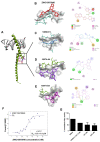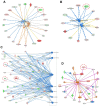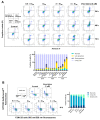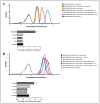Modes of Action of a Novel c-MYC Inhibiting 1,2,4-Oxadiazole Derivative in Leukemia and Breast Cancer Cells
- PMID: 37570631
- PMCID: PMC10419799
- DOI: 10.3390/molecules28155658
Modes of Action of a Novel c-MYC Inhibiting 1,2,4-Oxadiazole Derivative in Leukemia and Breast Cancer Cells
Abstract
The c-MYC oncogene regulates multiple cellular activities and is a potent driver of many highly aggressive human cancers, such as leukemia and triple-negative breast cancer. The oxadiazole class of compounds has gained increasing interest for its anticancer activities. The aim of this study was to investigate the molecular modes of action of a 1,2,4-oxadiazole derivative (ZINC15675948) as a c-MYC inhibitor. ZINC15675948 displayed profound cytotoxicity at the nanomolar range in CCRF-CEM leukemia and MDA-MB-231-pcDNA3 breast cancer cells. Multidrug-resistant sublines thereof (i.e., CEM/ADR5000 and MDA-MB-231-BCRP) were moderately cross-resistant to this compound (<10-fold). Molecular docking and microscale thermophoresis revealed a strong binding of ZINC15675948 to c-MYC by interacting close to the c-MYC/MAX interface. A c-MYC reporter assay demonstrated that ZINC15675948 inhibited c-MYC activity. Western blotting and qRT-PCR showed that c-MYC expression was downregulated by ZINC15675948. Applying microarray hybridization and signaling pathway analyses, ZINC15675948 affected signaling routes downstream of c-MYC in both leukemia and breast cancer cells as demonstrated by the induction of DNA damage using single cell gel electrophoresis (alkaline comet assay) and induction of apoptosis using flow cytometry. ZINC15675948 also caused G2/M phase and S phase arrest in CCRF-CEM cells and MDA-MB-231-pcDNA3 cells, respectively, accompanied by the downregulation of CDK1 and p-CDK2 expression using western blotting. Autophagy induction was observed in CCRF-CEM cells but not MDA-MB-231-pcDNA3 cells. Furthermore, microarray-based mRNA expression profiling indicated that ZINC15675948 may target c-MYC-regulated ubiquitination, since the novel ubiquitin ligase (ELL2) was upregulated in the absence of c-MYC expression. We propose that ZINC15675948 is a promising natural product-derived compound targeting c-MYC in c-MYC-driven cancers through DNA damage, cell cycle arrest, and apoptosis.
Keywords: 1,2,4-oxadiazole; c-MYC inhibitor; leukemia; natural product derivative; oncogenes; triple-negative breast cancer.
Conflict of interest statement
The authors declare no conflict of interest.
Figures











Similar articles
-
The cardiac glycoside ZINC253504760 induces parthanatos-type cell death and G2/M arrest via downregulation of MEK1/2 phosphorylation in leukemia cells.Cell Biol Toxicol. 2023 Dec;39(6):2971-2997. doi: 10.1007/s10565-023-09813-w. Epub 2023 Jun 16. Cell Biol Toxicol. 2023. PMID: 37322258 Free PMC article.
-
The cytotoxic activities of the major diterpene extracted from Salvia multicaulis (Bardakosh) are mediated by the regulation of heat-shock response and fatty acid metabolism pathways in human leukemia cells.Phytomedicine. 2024 Dec;135:156023. doi: 10.1016/j.phymed.2024.156023. Epub 2024 Sep 27. Phytomedicine. 2024. PMID: 39368339
-
The Novel Artemisinin Dimer Isoniazide ELI-XXIII-98-2 Induces c-MYC Inhibition, DNA Damage, and Autophagy in Leukemia Cells.Pharmaceutics. 2023 Mar 30;15(4):1107. doi: 10.3390/pharmaceutics15041107. Pharmaceutics. 2023. PMID: 37111592 Free PMC article.
-
2α-Hydroxyalantolactone from Pulicaria undulata: activity against multidrug-resistant tumor cells and modes of action.Phytomedicine. 2021 Jan;81:153409. doi: 10.1016/j.phymed.2020.153409. Epub 2020 Nov 17. Phytomedicine. 2021. PMID: 33341310
-
Two palladium (II) complexes derived from halogen-substituted Schiff bases and 2-picolylamine induce parthanatos-type cell death in sensitive and multi-drug resistant CCRF-CEM leukemia cells.Eur J Pharmacol. 2023 Oct 5;956:175980. doi: 10.1016/j.ejphar.2023.175980. Epub 2023 Aug 9. Eur J Pharmacol. 2023. PMID: 37567459
Cited by
-
Anti-Inflammatory and Cancer-Preventive Potential of Chamomile (Matricaria chamomilla L.): A Comprehensive In Silico and In Vitro Study.Biomedicines. 2024 Jul 5;12(7):1484. doi: 10.3390/biomedicines12071484. Biomedicines. 2024. PMID: 39062057 Free PMC article.
-
In Silico, In Vitro, and In Vivo Investigations on Adapalene as Repurposed Third Generation Retinoid against Multiple Myeloma and Leukemia.Cancers (Basel). 2023 Aug 16;15(16):4136. doi: 10.3390/cancers15164136. Cancers (Basel). 2023. PMID: 37627164 Free PMC article.
-
In vitro antitumor and immunomodulatory activities of 1,2,4-oxadiazole derivatives.Biochem Biophys Rep. 2025 Feb 10;41:101950. doi: 10.1016/j.bbrep.2025.101950. eCollection 2025 Mar. Biochem Biophys Rep. 2025. PMID: 40028040 Free PMC article.
-
1,2,4-Oxadiazole Derivatives: Physicochemical Properties, Antileishmanial Potential, Docking and Molecular Dynamic Simulations of Leishmania infantum Target Proteins.Molecules. 2024 Sep 30;29(19):4654. doi: 10.3390/molecules29194654. Molecules. 2024. PMID: 39407583 Free PMC article.
-
In Silico Study of the Anti-MYC Potential of Lanostane-Type Triterpenes.ACS Omega. 2024 Dec 12;9(51):50844-50858. doi: 10.1021/acsomega.4c10201. eCollection 2024 Dec 24. ACS Omega. 2024. PMID: 39741863 Free PMC article.
References
-
- Sammak S., Hamdani N., Gorrec F., Allen M.D., Freund S.M.V., Bycroft M., Zinzalla G. Crystal structures and nuclear magnetic resonance studies of the apo form of the c-MYC: MAX bHLHZip complex reveal a helical basic region in the absence of DNA. Biochemistry. 2019;58:3144–3154. doi: 10.1021/acs.biochem.9b00296. - DOI - PMC - PubMed
MeSH terms
Substances
LinkOut - more resources
Full Text Sources
Medical
Miscellaneous

